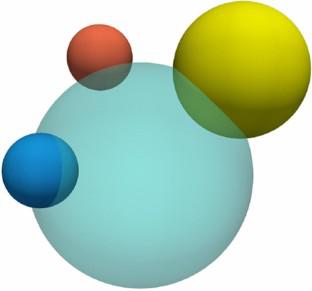Engineering with Computers ( IF 8.7 ) Pub Date : 2024-01-18 , DOI: 10.1007/s00366-023-01921-9 Ruochun Zhang , Colin Vanden Heuvel , Alexander Schepelmann , Arno Rogg , Dimitrios Apostolopoulos , Samuel Chandler , Radu Serban , Dan Negrut

|
This paper discusses the use of the discrete element method (DEM) to simulate the dynamics of granular systems made up of elements with nontrivial geometries. The DEM simulator is GPU accelerated and can handle elements whose shape is defined as the union with overlap of diverse sets of spheres with user-specified radii. The simulator can also handle complex materials since each sphere in an element can have its own Young’s modulus E, Poisson ratio \(\nu\), friction coefficient \(\mu\), and coefficient of restitution CoR. To demonstrate the simulator, this paper introduces a “digital simulant” (DS), a replica of the GRC-1 lunar simulant. The DS follows an element size distribution similar but not identical to that of GRC-1. The predictive attributes of the simulator are validated via several numerical experiments: repose angle, cone penetration, drawbar pull, and rover incline-climbing tests. Subsequently, a sensitivity analysis is carried out to gauge how the slope vs. slip curves change when the element shape, element size, and friction coefficient change. The paper concludes with a VIPER rover simulation that confirms a recently proposed granular scaling law. The simulation involves more than 11 million elements composed of more than 34 million spheres of different radii. The simulator works in the Chrono framework and can utilize two GPUs concurrently. The GPU code for the simulator and all numerical experiments discussed are open-source and available on GitHub for reproducibility studies and unfettered use and distribution. The DEM simulator introduced here: can handle complex particle geometry; can capture material breakage; can handle user-defined contact forces; allows for one DEM element to have different material properties in different regions of the element; is fast and runs on commodity hardware; can leverage two GPU cards simultaneously; it has a Python interface; and, it works in co-simulation mode with and augments Chrono, an established multi-body dynamics platform that supports the physics-based simulation of complex mechanical systems.
中文翻译:

用于对由块状元素组成的颗粒系统进行 DEM 分析的 GPU 加速模拟器
本文讨论了使用离散元法 (DEM) 来模拟由具有非平凡几何形状的元素组成的颗粒系统的动力学。DEM 模拟器采用 GPU 加速,可以处理形状定义为具有用户指定半径的不同球体集重叠的并集的元素。该模拟器还可以处理复杂的材料,因为单元中的每个球体都可以有自己的杨氏模量E、泊松比\(\nu\)、摩擦系数\(\mu\)和恢复系数 CoR。为了演示模拟器,本文介绍了一种“数字模拟物”(DS),它是 GRC-1 月球模拟物的复制品。DS 遵循与 GRC-1 类似但不相同的单元尺寸分布。模拟器的预测属性通过多项数值实验进行了验证:休止角、锥入度、牵引杆拉力和流动站倾斜爬升测试。随后,进行灵敏度分析,以衡量当单元形状、单元尺寸和摩擦系数变化时斜率与滑移曲线如何变化。该论文以 VIPER 漫游车模拟作为结论,证实了最近提出的粒度缩放定律。模拟涉及超过 1100 万个单元,由超过 3400 万个不同半径的球体组成。该模拟器在 Chrono 框架中运行,可以同时使用两个 GPU。模拟器的 GPU 代码和讨论的所有数值实验都是开源的,可在 GitHub 上获取,以进行再现性研究以及不受限制的使用和分发。这里介绍的DEM模拟器:可以处理复杂的粒子几何形状;可捕捉材料破损情况;可以处理用户定义的接触力;允许一个 DEM 元素在该元素的不同区域具有不同的材料属性;速度快并且在商用硬件上运行;可以同时利用两个GPU卡;它有一个Python接口;而且,它与 Chrono 协同仿真模式工作并对其进行增强,Chrono 是一个成熟的多体动力学平台,支持复杂机械系统的基于物理的仿真。



























 京公网安备 11010802027423号
京公网安备 11010802027423号